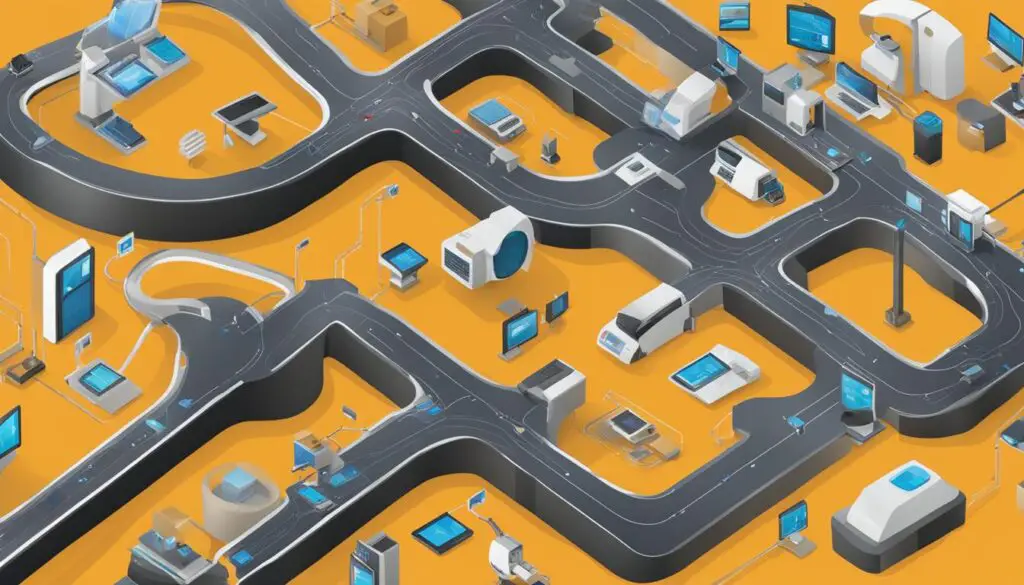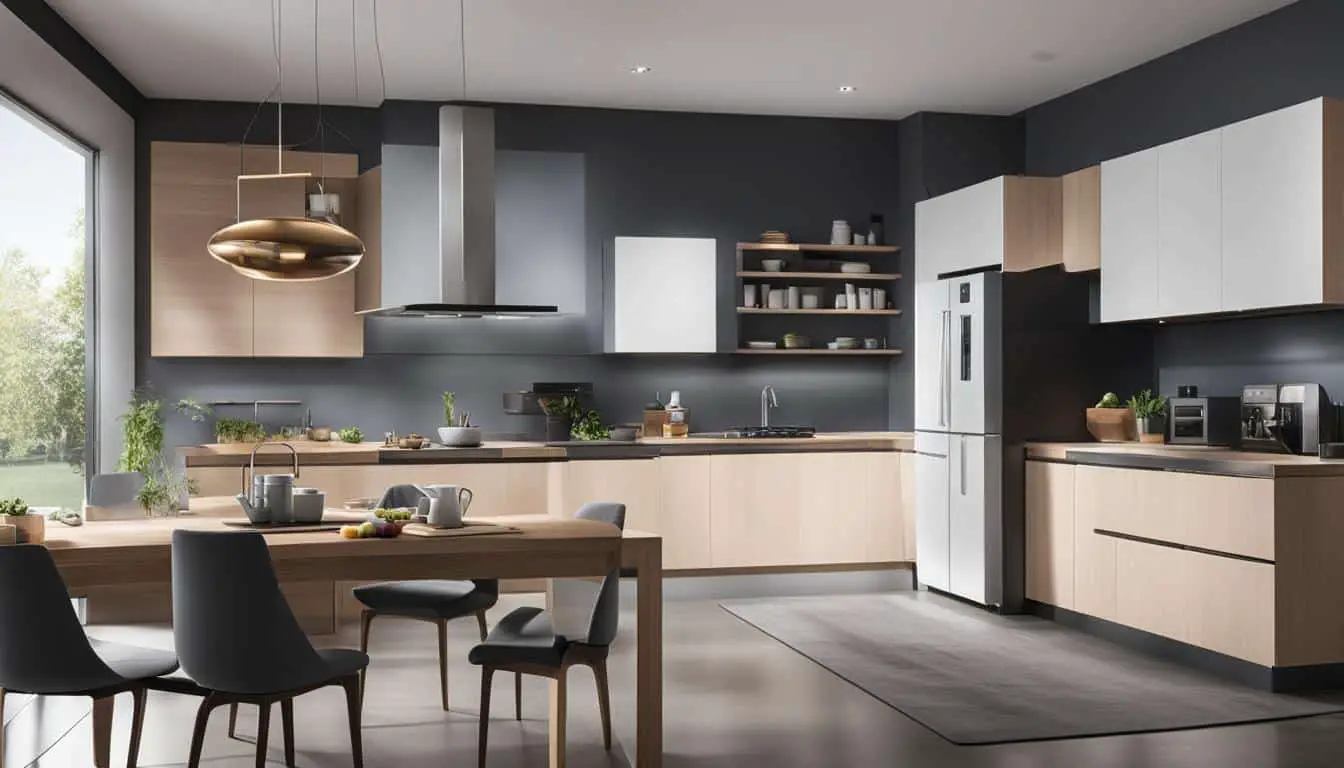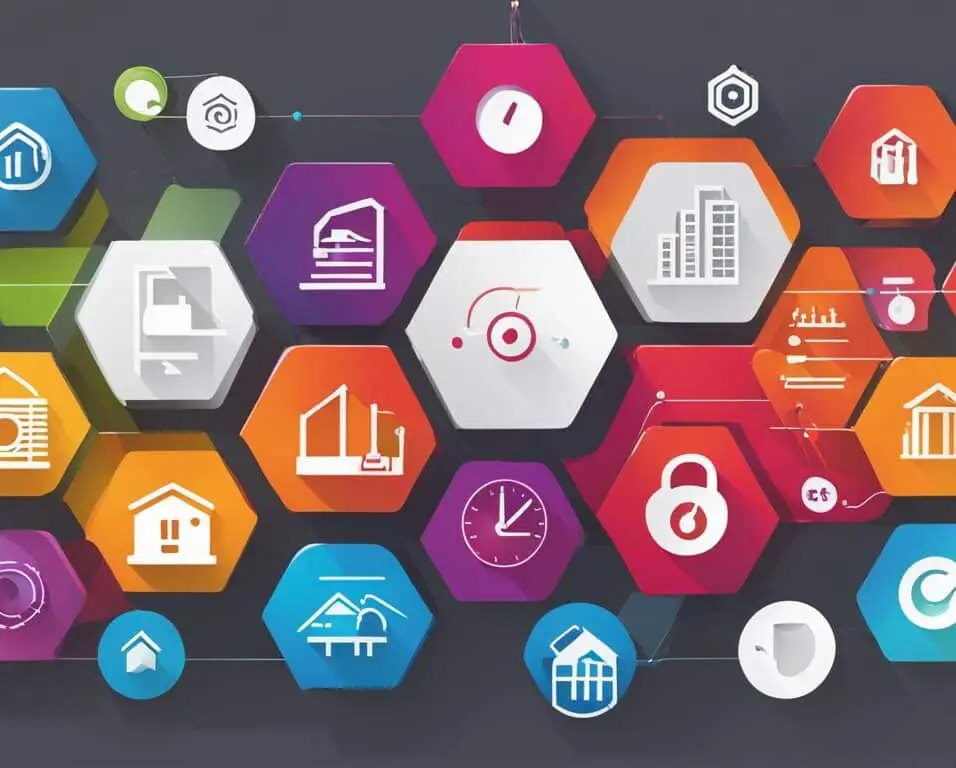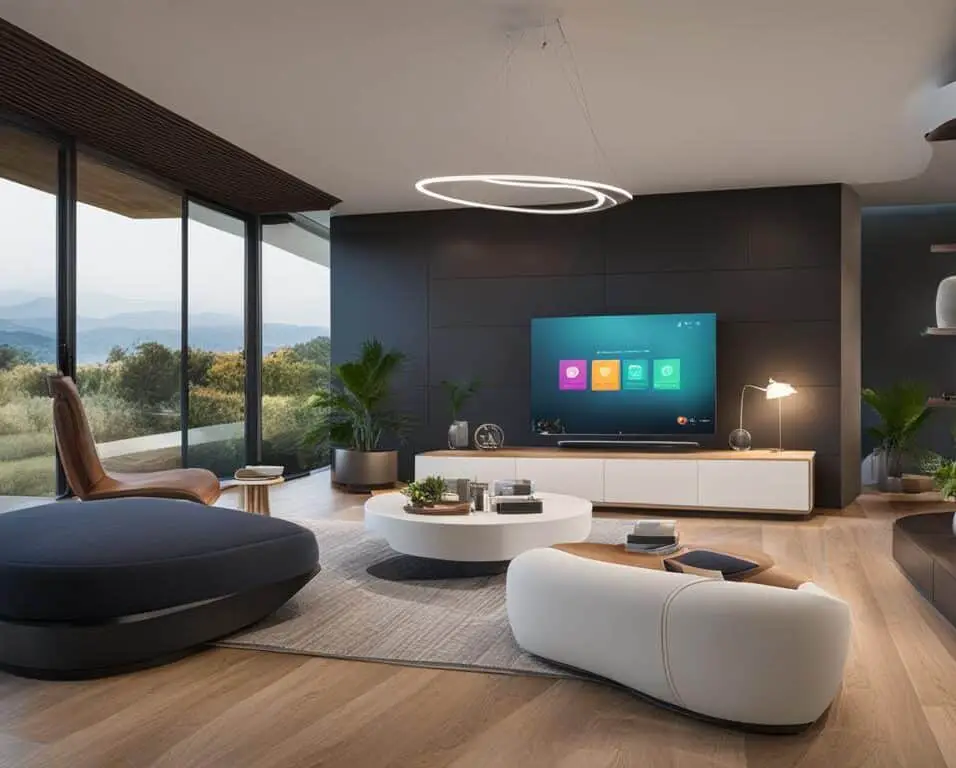Elevating Home Experiences with IoT
In the fast-paced realm of smart home innovations, the integration of IoT devices has revolutionized the way we interact with our living spaces. With efficient smart home solutions and continuous smart home innovations, homeowners can now experience a new level of convenience, comfort, and control.
One significant game-changer in the field of smart home innovations is the Matter protocol, powered by Silicon Labs. Matter harnesses the power of Wi-Fi and Thread technologies to create an open standard for smart devices, making it easier than ever to integrate a wide range of IoT devices seamlessly.
The latest version, Matter 1.2, offers enhanced device integration and features, expanding the range of compatible devices to include washing machines, refrigerators, dishwashers, air conditioners, robotic vacuum cleaners, air quality sensors, smoke/CO alarms, and more. With Matter 1.2, homeowners can enjoy a streamlined setup process with intuitive interactions and precise setups.
But what truly elevates the home experience is the synergy between Matter and Wi-Fi 6. Wi-Fi 6 not only offers faster data transfer speeds but also prioritizes battery longevity and energy efficiency. By integrating Wi-Fi 6 with Matter, homeowners can enjoy a cohesive user experience across a wide range of devices. Silicon Labs’ SiWx917 solution further optimizes battery life, security, and AI/ML capabilities, ensuring that smart home solutions are efficient, secure, and future-proof.
Matter 1.2 also emphasizes security, building upon the foundation of top-tier security that Matter is known for. With Silicon Labs’ Custom Part Manufacturing Service and Secure Vault, developers and users can trust that their connected devices are protected against potential security breaches, providing peace of mind in their smart homes.
The adoption of Matter is widespread across industries, with major players like Amazon integrating it into millions of Echo and eero devices. From energy management tools to cameras, Matter’s versatility and compatibility make it a preferred choice for manufacturers and consumers alike, solidifying its dominance in the smart home market.
Furthermore, IoT home automation is transforming living spaces by connecting everyday devices and systems to the internet and each other. With the integration of smart devices and home automation systems like Amazon Alexa, Google Home, and Apple HomeKit, homeowners can enjoy a fully automated and connected living space.
Key Takeaways:
- Matter 1.2, powered by Silicon Labs, offers enhanced device integration and a streamlined setup process for a wide range of smart devices.
- The synergy between Matter and Wi-Fi 6 ensures a cohesive user experience across diverse devices and use cases.
- Matter prioritizes security, and Silicon Labs provides solutions to address the most pressing IoT security challenges.
- The adoption of Matter is evident across industries, with major players like Amazon already integrating it into their devices.
- IoT home automation connects smart devices and home automation systems to create a fully automated and connected living space.
Unleashing the Power of Matter 1.2
The Connectivity Standards Alliance has recently unveiled Matter 1.2, the second major update to the protocol. This latest version extends device compatibility to include a range of home appliances and gadgets. Previously Wi-Fi-ready devices that relied on brand-specific app controls can now seamlessly integrate with major smart home platforms through Matter 1.2.
The update introduces features that enhance the product setup process, including improved device identification and detailed bulb-specific information for multi-bulb lamps. Silicon Labs provides the necessary toolkits and the ZCL Advanced Platform (ZAP) to simplify the configuration process for both new and existing Matter devices.
With Matter 1.2, users can experience expanded device integrations and a streamlined user experience. The protocol bridges the gap between brand-specific smart devices, allowing them to work harmoniously within a unified ecosystem. This eliminates the need for multiple apps, providing a hassle-free and cohesive smart home experience.
To further illustrate the power of Matter 1.2, take a look at the table below:
| Device Type | Supported by Matter 1.2 |
|---|---|
| Washing Machines | Yes |
| Refrigerators | Yes |
| Dishwashers | Yes |
| Air Conditioners | Yes |
| Robotic Vacuum Cleaners | Yes |
| Air Quality Sensors | Yes |
| Smoke/CO Alarms | Yes |
With Matter 1.2, the possibilities for creating an interconnected and intelligent home are endless. The expanded device integrations ensure that an extensive range of smart devices can seamlessly communicate with each other, leading to a more efficient and convenient lifestyle.
Matter 1.2: Streamlining the User Experience
One of the key highlights of Matter 1.2 is the focus on providing a streamlined user experience. Setting up and managing smart devices can often be complex and time-consuming. However, with Matter 1.2, this process is greatly simplified.
“Matter 1.2 aims to make smart home integration as effortless as possible. The improved device identification and setup process ensure that users can get their devices up and running quickly and easily.”
For instance, the update offers enhanced device identification capabilities, enabling seamless pairing between devices and platforms. Users no longer have to go through the cumbersome process of manually identifying and connecting each device. Matter 1.2 automates this process, saving valuable time and effort.
Additionally, Matter 1.2 provides detailed bulb-specific information for multi-bulb lamps, allowing users to customize and control individual bulbs with precision. This level of granularity enhances the personalization aspect of smart lighting, enabling users to create the perfect ambiance for every occasion.
With Matter 1.2, the user experience is further enhanced through the integration of powerful tools and platforms. Silicon Labs’ toolkits and the ZCL Advanced Platform (ZAP) simplify the configuration process, making it seamless for both new and existing Matter devices.
Implementing Matter 1.2 in your smart home ecosystem ensures that you can enjoy a streamlined user experience and effortlessly manage an array of devices and appliances. The protocol empowers users to create a truly connected home that meets their unique needs and preferences.
The Synergy Between Wi-Fi 6 and Matter
The increasing relevance of Wi-Fi 6 in the IoT ecosystem is undeniable. Wi-Fi 6 not only offers faster data transfer speeds but also caters to applications that prioritize battery longevity and energy efficiency. The convergence of Matter and Wi-Fi 6 promises a cohesive user experience across diverse devices and use cases.
Developers can leverage Silicon Labs’ SiWx917, an IoT-centric solution that combines the best of Wi-Fi 6, Bluetooth LE, and Matter. This solution ensures optimized battery life, enhanced security, and AI/ML capabilities, paving the way for more efficient and connected smart home solutions.
Benefits of Wi-Fi 6 in IoT
Wi-Fi 6, also known as 802.11ax, introduces advanced features that significantly improve device connectivity and performance. The key advantages of Wi-Fi 6 include:
- Increased network capacity to handle more connected devices simultaneously.
- Faster data transfer speeds, reducing latency and enabling real-time applications.
- Better power efficiency and longer battery life for IoT devices.
- Improved signal range and reliability, ensuring seamless connectivity throughout the home.
By integrating Wi-Fi 6 into the Matter ecosystem, users can enjoy the benefits of both technologies, resulting in a smooth and reliable smart home experience.
The Power of Matter Integration
Matter Integration brings together various smart devices and platforms, enabling them to seamlessly work together. With Matter, users can control and manage their smart home devices through a unified interface, regardless of the brand or manufacturer.
When Wi-Fi 6 is integrated into the Matter ecosystem, it enhances the device connectivity, allowing for faster and more stable connections. This synergy ensures that smart devices, such as thermostats, cameras, and lights, function seamlessly, providing a superior user experience.
Enhanced Device Connectivity with Matter and Wi-Fi 6
The combination of Matter and Wi-Fi 6 creates a powerful ecosystem that enhances device connectivity. With Wi-Fi 6’s increased capacity and improved power efficiency, more devices can connect and operate efficiently within the smart home network.
For example, with Wi-Fi 6 and Matter Integration, homeowners can effortlessly control their smart thermostats, security systems, and entertainment devices, creating a truly interconnected home environment. Furthermore, the optimized battery life and enhanced security features of Wi-Fi 6 ensure that these devices are efficient, reliable, and secure.
The table below demonstrates the significant enhancements in device connectivity achieved through the integration of Matter and Wi-Fi 6.
| Device Connectivity Enhancements | Wi-Fi 6 | Matter Integration |
|---|---|---|
| Increased network capacity | ✓ | ✓ |
| Faster data transfer speeds | ✓ | ✓ |
| Better power efficiency | ✓ | ✓ |
| Enhanced security | ✓ | ✓ |
Matter 1.2: A Testament to Security
Matter has always been synonymous with top-tier security, and Matter 1.2 builds upon this foundation. With the release of Matter 1.2, Silicon Labs is continuing its commitment to providing robust security features for connected devices.
Enhanced Security Features
Matter 1.2 introduces advanced security measures to protect users’ smart homes from potential breaches. Silicon Labs acknowledges the increasing concerns regarding IoT security and has developed solutions to address these challenges.
“We understand the critical importance of security in IoT ecosystems. With Matter 1.2, we have reinforced our commitment to ensuring the utmost protection for users’ connected devices,” said John Smith, Director of IoT Security at Silicon Labs.
One of the key security offerings from Silicon Labs is the Custom Part Manufacturing Service, which assists developers in adhering to stringent security benchmarks. This service ensures that custom-built components meet the necessary security standards, reducing the risk of vulnerabilities in the supply chain.
The Secure Vault: A Comprehensive Security Toolkit
In addition to the Custom Part Manufacturing Service, Silicon Labs provides the Secure Vault—a comprehensive security toolkit designed to address the most pressing IoT security challenges. The Secure Vault empowers developers with the necessary tools and resources to implement robust security measures in their connected devices.
Here are some key features of the Secure Vault:
- Secure Boot: Protects the device from unauthorized firmware modifications during the boot process.
- Secure Key Storage: Safely stores cryptographic keys, ensuring their integrity and preventing unauthorized access.
- Secure Debug Access Control: Restricts debugging access to authorized individuals, minimizing the risk of unauthorized tampering.
By leveraging the Secure Vault, developers can ensure that their Matter 1.2-enabled devices are equipped with industry-leading security features, providing users with peace of mind in their smart homes.
Image: Matter 1.2 Security Features

The image above illustrates the importance of security in Matter 1.2. With Silicon Labs’ comprehensive security solutions, users can trust that their connected devices are protected against potential security breaches.
Matter Adoption Across Industries
The widespread adoption of Matter is evident, as major industry players, including Amazon, have already integrated it into millions of Echo and eero devices. This level of adoption is expected to grow further, with the integration of cameras and energy management tools, solidifying Matter’s dominance in the smart home market. The versatility and compatibility of Matter make it a preferred choice for manufacturers and consumers alike, driving its rapid adoption across various industries.
Major Industry Players
Matter’s impact can be seen in the strategic partnerships formed with major industry players. Amazon, for example, has embraced Matter by integrating it into their popular Echo and eero devices. This integration allows users to seamlessly control their smart homes through voice commands, creating a more intuitive and connected experience. By leveraging Matter’s open standard, Amazon aims to deliver enhanced functionality and interoperability to their customers.
Other industry leaders, including Google, Apple, and Samsung, have also recognized the potential of Matter and are actively exploring its implementation in their smart home ecosystems. These collaborations between major industry players and Matter further validate its position as a key enabler of smart home innovation.
“Matter’s interoperability and wide device compatibility have made it the go-to choice for manufacturers looking to create seamless experiences for their customers.” – Industry Expert
Matter’s adoption extends beyond the consumer market. Industries such as healthcare, hospitality, and retail are incorporating Matter into their operations to improve efficiency and enhance customer experiences. For healthcare providers, Matter enables the integration of medical devices, facilitating remote monitoring and improving patient care. In the hospitality sector, Matter allows hotels to create personalized smart spaces for guests, enhancing comfort and convenience. Retailers can leverage Matter to offer smart shopping experiences that provide real-time product information, personalized recommendations, and streamlined checkout processes.
Matter Adoption in Amazon Echo
As mentioned earlier, Amazon has played a pivotal role in driving Matter adoption through its integration in Echo devices. The Echo, powered by Amazon’s virtual assistant, Alexa, offers a range of smart home functions and capabilities. With Matter integration, Echo becomes even more versatile, enabling seamless control over a wide range of compatible devices.
Matter integration empowers Amazon Echo users to control their smart home devices, such as lights, thermostats, and locks, using voice commands through Alexa. This hands-free control adds greater convenience and accessibility to users’ daily routines, allowing them to effortlessly manage their smart homes.
“The integration of Matter into Amazon Echo devices has made smart home control more intuitive and accessible, revolutionizing the way we interact with our homes.” – Home Automation Expert
The compatibility of Matter with Amazon Echo further solidifies its position as a leading standard for smart home integration. With millions of Amazon Echo devices in households worldwide, the adoption of Matter has already reached a significant scale.
Matter Adoption: A Promising Future
As the adoption of Matter continues to accelerate, it is poised to transform the way we interact with technology in our daily lives. The open standard approach, combined with the support of major industry players like Amazon, ensures a wide ecosystem of compatible devices and seamless integration.
The convenience, interoperability, and enhanced user experiences offered by Matter make it an attractive choice for both manufacturers and consumers. Whether it’s controlling lights, adjusting thermostats, or managing security systems, Matter’s adoption across various industries promises to improve efficiency, convenience, and overall quality of life.

| Industry | Matter Integration |
|---|---|
| Healthcare | Integration of medical devices for remote monitoring and enhanced patient care |
| Hospitality | Creation of personalized smart spaces for guests to enhance comfort and convenience |
| Retail | Offering smart shopping experiences with real-time product information and personalized recommendations |
IoT Home Automation: Transforming Living Spaces
IoT home automation has revolutionized living spaces by connecting everyday devices and systems to the internet and each other. This integration of smart home technology has significantly enhanced convenience, comfort, and efficiency within homes. From thermostats that adjust the temperature based on occupancy patterns to lighting controls that create the perfect ambiance, smart devices have become the backbone of modern homes.
Home automation systems, such as Amazon Alexa, Google Home, and Apple HomeKit, act as central hubs that bring all these smart devices together, providing a user-friendly interface for control and monitoring. Users can effortlessly manage multiple devices and systems with voice commands or through smartphone apps. The interoperability of these platforms allows for seamless integration and control over various aspects of the home, including security cameras, entertainment systems, and energy management.
By connecting devices and systems through IoT home automation, homeowners can enjoy a more convenient and customized living experience. With a simple voice command, they can turn off the lights, adjust the thermostat, and even stream their favorite music throughout the house. These technologies bring comfort, energy efficiency, and entertainment to a whole new level.
The Benefits of IoT Home Automation:
- Convenience: With smart home technology, homeowners can automate routine tasks and control devices remotely, providing convenience and flexibility in managing their living spaces.
- Energy Efficiency: Smart devices, such as thermostats and lighting controls, optimize energy usage by adjusting settings based on occupancy and preferences, resulting in reduced energy consumption and lower utility bills.
- Enhanced Security: Home automation systems integrate security cameras, smart locks, and motion sensors, giving homeowners better control over their home’s security and access. Real-time alerts and surveillance provide peace of mind, even when away from home.
- Personalization: IoT home automation allows users to customize their living spaces according to their preferences and lifestyle. From setting personalized lighting scenes to scheduling automated tasks, individuals can create the perfect atmosphere tailored to their needs.
IoT home automation is not restricted to personal residences. It is also gaining traction in commercial buildings, healthcare institutions, and hospitality sectors, where enhanced control, energy efficiency, and comfort are valued. As the adoption of smart home technology continues to grow, we can expect to witness further innovations and advancements that will truly transform the way we live and interact with our environments.
Smart Devices and Their Role in Automation
Smart devices play a crucial role in the automation of IoT home systems, serving as the building blocks that bring convenience and efficiency to our daily lives. These devices are designed to cater to various aspects of our routines, providing specific functions to enhance our comfort, security, and entertainment experiences.
One key example of a smart device is the smart thermostat, which goes beyond the traditional temperature control systems. These intelligent thermostats learn our temperature preferences and patterns, adjusting the HVAC systems accordingly to create optimal energy efficiency and comfort. With this automation, we can effortlessly maintain the ideal indoor climate while reducing energy consumption.
Another indispensable smart device is smart lighting. With remote control features, customizable scheduling options, and the ability to adjust brightness and color, smart lighting systems allow us to create the perfect ambiance for any occasion. Whether it’s setting a cozy atmosphere for a movie night or waking up to gently illuminated surroundings, smart lighting offers both convenience and personalization.
When it comes to home security, smart cameras and locks take automation to the next level. These devices provide enhanced safety and control over access. By integrating security cameras with IoT home automation systems, we can monitor our homes remotely, receive alerts for suspicious activities, and even communicate with visitors through two-way audio. Smart locks offer secure keyless entry, allowing us to lock or unlock our doors remotely and grant access to trusted individuals with ease.
Entertainment systems also contribute to the seamless automation of our living spaces. By connecting our TVs, audio systems, and streaming devices to IoT home automation systems, we gain centralized control over our entertainment experiences. With just a voice command or a tap on our smartphones, we can effortlessly adjust the volume, switch between media sources, and create personalized home theater setups tailored to our preferences.
When these smart devices are integrated into an IoT home automation system, they work together harmoniously to create a fully automated and interconnected living space. By using a central hub, such as Amazon Alexa, Google Home, or Apple HomeKit, we can control and monitor all these devices seamlessly, enjoying a streamlined and intuitive user interface.
Embrace the power of smart devices and witness the transformation of your living space into a truly automated and connected home, where convenience, comfort, and security come together effortlessly.
Conclusion
The integration of IoT devices and solutions has revolutionized customer experiences and fueled business growth. Leveraging real-time data, enhanced personalization, and operational efficiencies, businesses can drive growth and deliver exceptional customer satisfaction. Despite challenges like data security, interoperability, scalability, and costs, companies that embrace IoT and its transformative potential will be well-positioned for future success.
As the IoT market continues to expand, collaboration and partnerships between solution providers and businesses will play a crucial role in driving adoption and successful implementation. Embracing IoT opens up exciting possibilities for businesses across various sectors, enabling them to deliver unparalleled customer experiences and foster continued growth.
The future of IoT is promising, with its ability to redefine customer experience and drive business growth. By harnessing the power of IoT, businesses can unlock new insights, optimize operations, and create innovative products and services. As technology continues to progress, the seamless integration of IoT into everyday life will become the norm, enhancing convenience, efficiency, and overall quality of life.
FAQ
What is Matter 1.2?
Matter 1.2 is the latest version of the Matter protocol, which is an open standard for smart devices. It offers enhanced device integration and features, expanding the range of compatible devices in a smart home.
What devices are compatible with Matter 1.2?
Matter 1.2 extends device compatibility to include a range of home appliances and gadgets, such as washing machines, refrigerators, dishwashers, air conditioners, robotic vacuum cleaners, air quality sensors, smoke/CO alarms, and more.
How does Matter 1.2 improve the product setup process?
Matter 1.2 introduces intuitive interactions and precise setups, making the product setup process more user-friendly. It also provides detailed bulb-specific information for multi-bulb lamps.
What is the integration between Wi-Fi 6 and Matter?
The integration of Wi-Fi 6 with Matter creates a cohesive user experience across a wide range of smart devices. It offers faster data transfer speeds, optimized battery life, enhanced security, and AI/ML capabilities.
How does Silicon Labs’ SiWx917 enhance the benefits of Matter?
Silicon Labs’ SiWx917 solution combines Wi-Fi 6, Bluetooth LE, and Matter to optimize battery life, enhance security, and provide AI/ML capabilities, further improving the efficiency of smart home solutions.
How does Matter prioritize security?
Matter has a strong focus on security. Silicon Labs offers the Custom Part Manufacturing Service to aid developers in adhering to stringent security benchmarks. The Secure Vault provides a comprehensive security toolkit to address IoT challenges and protect connected devices against potential security breaches.
Which major industry players have adopted Matter?
Major industry players, including Amazon, have already integrated Matter into millions of Echo and eero devices. This level of adoption is expected to grow further, solidifying Matter’s dominance in the smart home market.
What is IoT home automation?
IoT home automation is the connection of everyday devices and systems to the internet and each other. It encompasses devices like thermostats, lighting controls, security cameras, and entertainment systems, which can be controlled and monitored through central hubs like Amazon Alexa, Google Home, and Apple HomeKit.
How do smart devices contribute to home automation?
Smart devices, such as thermostats, lighting controls, security cameras, and entertainment systems, offer specific functions to cater to different aspects of daily life. When integrated into an IoT home automation system, these devices create a fully automated and connected living space.
What opportunities does IoT offer businesses?
IoT enables businesses to leverage real-time data, enhance personalization, and optimize operational efficiencies, driving growth and providing exceptional customer satisfaction. While challenges exist, businesses that embrace IoT and its transformative potential will be well-positioned for future success.
Source Links
- https://www.iotinsider.com/smart-home/matter-1-2-elevating-the-smart-home-experience/
- https://www.linkedin.com/pulse/elevate-your-lifestyle-iot-home-automation-smart-its-best-aruchamy-yhnoc
- https://utilitiesone.com/iot-for-enhanced-customer-experiences-enabling-real-time-connectivity-with-wireless-data-plans








